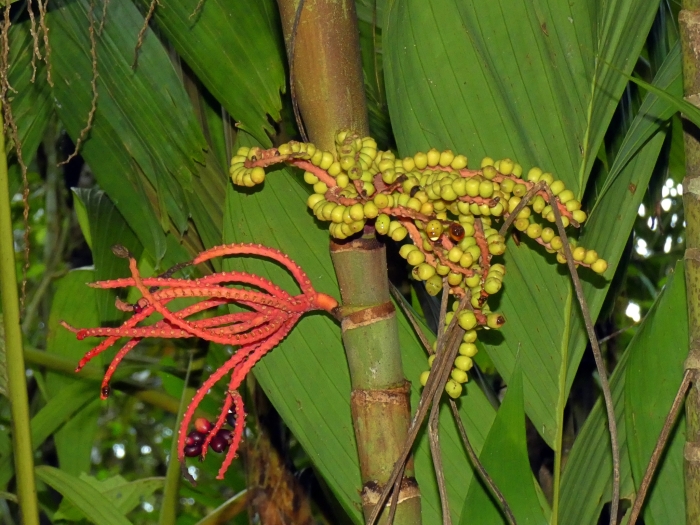Coronata Palm
(Pinanga coronata)
Coronata Palm (Pinanga coronata)
/
/

© Kai Squires
CC BY 4.0
Image By:
© Kai Squires
Recorded By:
Copyright:
CC BY 4.0
Copyright Notice:
Photo by: © Kai Squires | License Type: CC BY 4.0 | License URL: http://creativecommons.org/licenses/by/4.0/ | Uploader: squiresk | Publisher: iNaturalist |























Estimated Native Range
Summary
Pinanga coronata, commonly known as Coronata Palm, is a tropical palm native to the understory of humid rainforests in Indonesia. It is an evergreen plant that can reach up to 20 feet (6 meters) in height, with a slender, ringed trunk and a crown of pinnate leaves that can be up to 6 feet (1.8 meters) long. The leaves are glossy and feather-like, with a distinctive fishtail appearance at the leaflet tips, which adds to its ornamental value. The Coronata Palm produces small, yellow to cream flowers that are followed by attractive, clustered, red to black fruits, although the flowers are not particularly showy.
In cultivation, Pinanga coronata is appreciated for its elegant form and the tropical ambiance it brings to landscapes and indoor spaces. It is commonly used in tropical and subtropical gardens, as an understory plant in shaded areas, and as a striking indoor specimen in large containers. This palm prefers consistently moist, well-draining soil and thrives in partial to full shade, making it suitable for growing under the canopy of larger trees. It requires high humidity and warm temperatures, which should be considered when grown indoors or in temperate regions. While generally disease-resistant, it can be susceptible to pests such as spider mites, especially when grown indoors.CC BY-SA 4.0
In cultivation, Pinanga coronata is appreciated for its elegant form and the tropical ambiance it brings to landscapes and indoor spaces. It is commonly used in tropical and subtropical gardens, as an understory plant in shaded areas, and as a striking indoor specimen in large containers. This palm prefers consistently moist, well-draining soil and thrives in partial to full shade, making it suitable for growing under the canopy of larger trees. It requires high humidity and warm temperatures, which should be considered when grown indoors or in temperate regions. While generally disease-resistant, it can be susceptible to pests such as spider mites, especially when grown indoors.CC BY-SA 4.0
Plant Description
- Plant Type: Shrub, Tree
- Height: 6-30 feet
- Width: 3-16 feet
- Growth Rate: Moderate
- Flower Color: Purple
- Flowering Season: Spring
- Leaf Retention: Evergreen
Growth Requirements
- Sun: Part Shade
- Water: Medium
- Drainage: Medium
Common Uses
Low Maintenance, Potted Plant
Natural Habitat
native to the understory of humid rainforests in Indonesia
Other Names
Common Names: Java Pinanga Palm, Pinang Jawa
Scientific Names: , Pinanga coronata, Areca coronata, Areca coronata, Areca costata, Areca oriziformis var. gracilis, Pinanga coronata var. teijsmannii, Pinanga costata, Pinanga kuhlii, Pinanga kuhlii var. alba
GBIF Accepted Name: